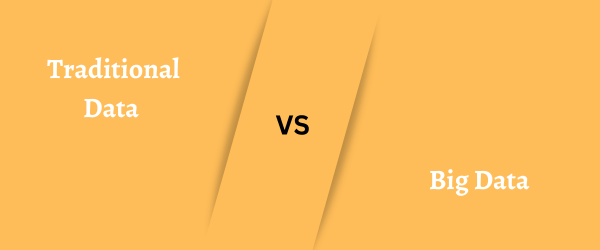Difference between Traditional Data and Big DataWith the increase in data day by day, it has become a vital asset for various businesses and organizations who want to gain a competitive advantage and improve their operations to grow their businesses and organizations. It is essential to carefully evaluate the data needs and capabilities to choose the best approach for managing and analyzing their data. According to your business, data can be traditional data, which is small in size, and big data, which is large in size. 
In this article, we will know the difference between traditional data and big data, but before that, let us know the meaning of traditional data and big data. Traditional dataTraditional data refers to structured data which is collected and stored in formats like databases, spreadsheets, etc. Such data includes customer information, inventory records, financial statements, etc. This data is stored in relational databases such as SQL and other traditional data analysis tools. It can be easily processed and manually analyzed using traditional methods to gain insight into business operations. It can also be used to create reports and visualizations, so it plays a vital role in making the right profitable decisions after understanding the trends and patterns in the data. Big dataAs the word 'big data' suggests a large amount of data. It is complex data that cannot be handled using traditional data methods. In today's world, everybody has smartphones and uses the internet. Everyone uses various social media platforms, which generate extensive data. It is unstructured, structured, or semi-structured data, such as images, text, videos, etc. Big data is categorized with the concept of 5V's, which are volume, velocity and variety, veracity, and value. Volume: It is the amount of data that is generated and collected on a daily basis, which ranges from terabytes to petabytes of data. Velocity: It is the rate of speed at which data is generated, processed, and analyzed. Variety: It means different types of data, such as structured, semi-structured data, and unstructured data. Veracity: It means the accuracy and reliability of the data for drawing conclusions. Value: It refers to the insights from the data that can be used to make more profitable decisions to benefit businesses. Big data delivers both challenges and chances for businesses and organizations. On the one hand, storing, processing, and analyzing big data using traditional analysis tools is tough and costly. On the other hand, big data can deliver useful insights into supporting businesses to grow by making better decisions. There are many businesses and organizations these days that are investing in big data analytics tools to handle big data. The main differences between traditional data and big data are as follows:
Conclusion:In this article, we have understood the difference between traditional data and big data. We have concluded that traditional data refers to structured data that can be easily handled with the help of traditional techniques. In contrast, big data is a vast amount of semi-structured, structured, and unstructured data that requires specialized tools to handle the data. The main difference between traditional data and big data is that traditional data generates limited insights that are accurate and help small businesses grow; on the other hand, big data generates valuable deep insights that may be inconsistent or inaccurate and help big businesses grow.
Next TopicDifference Between
|
 For Videos Join Our Youtube Channel: Join Now
For Videos Join Our Youtube Channel: Join Now
Feedback
- Send your Feedback to [email protected]
Help Others, Please Share










